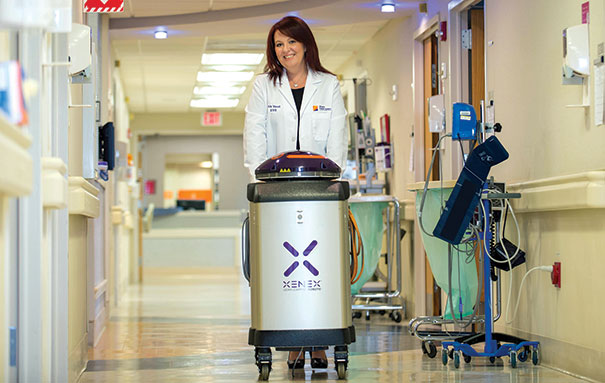 |
|
Photo by Kathy Cacicedo Iris Verdi, environmental services manager, wheels a xenon UV room disinfecting robot down the hallway in Overlook Medical Center, Summit, N.J. |
Later this year, the Affordable Care Act’s (ACA's) Hospital-Readmission Reduction and Value-based Purchasing programs begin impacting hospital payments based on their rates of infection, including Clostridium difficile.
Iris Verdi, environmental services (ES) manager, Overlook Medical Center, Summit, N.J., says while Overlook’s infection rates were on par with national averages, they have taken steps to improve performance on the measures that will impact reimbursement rates.
The 504-bed medical center, which serves as the anchor hospital for neurosciences in the Atlantic Health System, is one of six hospitals participating in a Joint Commission project to reduce C. difficile infections. In the project, participating hospitals and health networks are developing ways to eliminate barriers to effective infection prevention.
Participation in the program coupled with a team-based ES strategy that incorporates robotic ultraviolet (UV) technology enabled the medical center to reduce its C. difficile infection rate by 35 percent in targeted units in 2015.
Verdi, who was familiar with UV room disinfection technology when she joined Overlook in 2014, evaluated UV disinfection systems to enhance the facility’s cleaning protocols.
Overlook purchased a Xenex Germ-Zapping Robot, which uses full-spectrum pulsed xenon UV light to destroy pathogens including C. difficile and MRSA in five-minute disinfection cycles. The technology was put to the test before the purchase was finalized.
“When we were evaluating technologies, we had a Norovirus outbreak. At no charge, Xenex came in with staff and robots and disinfected the affected unit,” Verdi says. “They eradicated the Norovirus in three days; I’ve never seen an outbreak contained and shut down so quickly.”
The San Antonio, Texas-based company worked closely with the Overlook ES department to develop a customized plan targeting high-priority clinical units and optimize a bundled ES approach that includes hand hygiene and antibiotic stewardship to lower infection rates.
Initially, the plan focused on disinfecting rooms in a unit with a prevalence of patients with infections and pre-existing conditions. Robots were used extensively in rooms where patients had C. difficile infections and after discharges and terminal cleaning in the operating room (OR).
A second robot was purchased in 2015 to disinfect the critical care unit, intensive care unit, fecal transplant and endoscopy unit, orthopedic and neurology ORs, and the emergency department.
The ES department determined that assigning one staff member to use the robot on each shift was the most productive use of the technology. Decreasing patient lengths of stay by 239 days as a result of fewer infections more than paid for the three full-time employees assigned to operating the robots.
“Deploying a successful infection prevention program takes a lot of discipline,” Verdi says. “At first, there was some pushback on the additional 15 minutes required to disinfect a room. But now, we get calls from units that want us to disinfect certain rooms, especially when they treat a patient with an unusual condition.”
Communication plays an important role in the strategy. Weekly conference calls help the ES team stay on track, achieving 95 to 100 percent utilization in targeted areas. Verdi compiles a weekly compliance report for each unit so that managers are aware of infection prevention efforts. Impressive early results enabled Verdi to build a strong business case justifying additional UV units and staffing.
“The more we utilized the robots, the more infections we were preventing,” Verdi says.
HOSPITAL // Overlook Medical Center
NEED // Strategy to ensure compliance with Affordable Care Act infection rates
SOLUTION// Xenex Germ-Zapping Robot using xenon UV light





